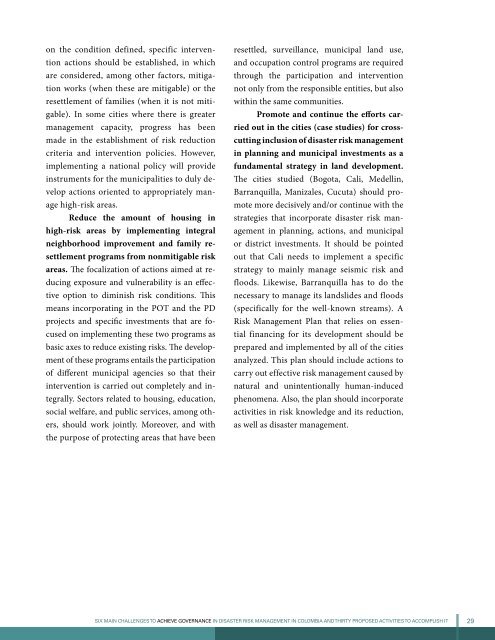Executive Summary - GFDRR
Executive Summary - GFDRR
Executive Summary - GFDRR
Create successful ePaper yourself
Turn your PDF publications into a flip-book with our unique Google optimized e-Paper software.
on the condition defined, specific intervention<br />
actions should be established, in which<br />
are considered, among other factors, mitigation<br />
works (when these are mitigable) or the<br />
resettlement of families (when it is not mitigable).<br />
In some cities where there is greater<br />
management capacity, progress has been<br />
made in the establishment of risk reduction<br />
criteria and intervention policies. However,<br />
implementing a national policy will provide<br />
instruments for the municipalities to duly develop<br />
actions oriented to appropriately manage<br />
high-risk areas.<br />
Reduce the amount of housing in<br />
high-risk areas by implementing integral<br />
neighborhood improvement and family resettlement<br />
programs from nonmitigable risk<br />
areas. The focalization of actions aimed at reducing<br />
exposure and vulnerability is an effective<br />
option to diminish risk conditions. This<br />
means incorporating in the POT and the PD<br />
projects and specific investments that are focused<br />
on implementing these two programs as<br />
basic axes to reduce existing risks. The development<br />
of these programs entails the participation<br />
of different municipal agencies so that their<br />
intervention is carried out completely and integrally.<br />
Sectors related to housing, education,<br />
social welfare, and public services, among others,<br />
should work jointly. Moreover, and with<br />
the purpose of protecting areas that have been<br />
resettled, surveillance, municipal land use,<br />
and occupation control programs are required<br />
through the participation and intervention<br />
not only from the responsible entities, but also<br />
within the same communities.<br />
Promote and continue the efforts carried<br />
out in the cities (case studies) for crosscutting<br />
inclusion of disaster risk management<br />
in planning and municipal investments as a<br />
fundamental strategy in land development.<br />
The cities studied (Bogota, Cali, Medellin,<br />
Barranquilla, Manizales, Cucuta) should promote<br />
more decisively and/or continue with the<br />
strategies that incorporate disaster risk management<br />
in planning, actions, and municipal<br />
or district investments. It should be pointed<br />
out that Cali needs to implement a specific<br />
strategy to mainly manage seismic risk and<br />
floods. Likewise, Barranquilla has to do the<br />
necessary to manage its landslides and floods<br />
(specifically for the well-known streams). A<br />
Risk Management Plan that relies on essential<br />
financing for its development should be<br />
prepared and implemented by all of the cities<br />
analyzed. This plan should include actions to<br />
carry out effective risk management caused by<br />
natural and unintentionally human-induced<br />
phenomena. Also, the plan should incorporate<br />
activities in risk knowledge and its reduction,<br />
as well as disaster management.<br />
Six MAIN challenges TO ACHIEVE governance in disaster risk management in Colombia and THIRTY proposed ACTIVITIES TO ACCOMPLISH it 29

















